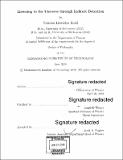Listening to the Universe through indirect detection
Author(s)
Rodd, Nicholas Llewellyn
DownloadFull printable version (101.2Mb)
Other Contributors
Massachusetts Institute of Technology. Department of Physics.
Advisor
Tracy R. Slatyer.
Terms of use
Metadata
Show full item recordAbstract
Indirect detection is the search for the particle nature of dark matter with astrophysical probes. Manifestly, it exists right at the intersection of particle physics and astrophysics, and the discovery potential for dark matter can be greatly extended using insights from both disciplines. This thesis provides an exploration of this philosophy. On the one hand, I will show how astrophysical observations of dark matter, through its gravitational interaction, can be exploited to determine the most promising locations on the sky to observe a particle dark matter signal. On the other, I demonstrate that refined theoretical calculations of the expected dark matter interactions can be used disentangle signals from astrophysical backgrounds. Both of these approaches will be discussed in the context of general searches, but also applied to the case of an excess of photons observed at the center of the Milky Way. This galactic center excess represents both the challenges and joys of indirect detection. Initially thought to be a signal of annihilating dark matter at the center of our own galaxy, it now appears more likely to be associated with a population of millisecond pulsars. Yet these pulsars were completely unanticipated, and highlight that indirect detection can lead to many new insights about the universe, hopefully one day including the particle nature of dark matter.
Description
Thesis: Ph. D., Massachusetts Institute of Technology, Department of Physics, 2018. Cataloged from PDF version of thesis. Includes bibliographical references (pages 325-374).
Date issued
2018Department
Massachusetts Institute of Technology. Department of PhysicsPublisher
Massachusetts Institute of Technology
Keywords
Physics.